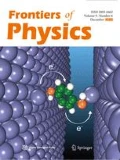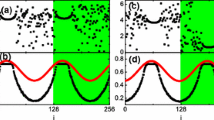Abstract
Chimera states consisting of spatially coherent and incoherent domains have been observed in different topologies such as rings, spheres, and complex networks. In this paper, we investigate bipartite networks of nonlocally coupled FitzHugh–Nagumo (FHN) oscillators in which the units are allocated evenly to two layers, and FHN units interact with each other only when they are in different layers. We report the existence of chimera states in bipartite networks. Owing to the interplay between chimera states in the two layers, many types of chimera states such as in-phase chimera states, antiphase chimera states, and out-of-phase chimera states are classified. Stability diagrams of several typical chimera states in the coupling strength–coupling radius plane, which show strong multistability of chimera states, are explored.
Similar content being viewed by others
References
Y. Kuramoto and D. Battogtokh, Coexistence of coherence and incoherence in nonlocally coupled phase oscillators, Nonlinear Phenom. Complex Syst. 5, 380 (2002), arXiv: cond-mat/0210694
D. Tanaka and Y. Kuramoto, Complex Ginzburg-Landau equation with nonlocal coupling, Phys. Rev. E 68(2), 026219 (2003)
S. I. Shima and Y. Kuramoto, Rotating spiral waves with phase-randomized core in nonlocally coupled oscillators, Phys. Rev. E 69(3), 036213 (2004)
D. M. Abrams and S. H. Strogatz, Chimera states for coupled oscillators, Phys. Rev. Lett. 93(17), 174102 (2004)
D. M. Abrams and S. H. Strogatz, Chimera states in a ring of nonlocally coupled oscillators, Int. J. Bifurcat. Chaos 16(01), 21 (2006)
N. C. Rattenborg, C. J. Amlaner, and S. L. Lima, Behavioral, neurophysiological and evolutionary perspectives on unihemispheric sleep, Neurosci. Biobehav. Rev. 24(8), 817 (2000)
A. E. Motter, S. A. Myers, M. Anghel, and T. Nishikawa, Spontaneous synchrony in power-grid networks, Nat. Phys. 9(3), 191 (2013)
J. C. González-Avella, M. G. Cosenza, and M. San Miguel, Localized coherence in two interacting populations of social agents, Physica A 399, 24 (2014)
D. M. Abrams, R. Mirollo, S. H. Strogatz, and D. A. Wiley, Solvable model for chimera states of coupled oscillators, Phys. Rev. Lett. 101(8), 084103 (2008)
G. C. Sethia, A. Sen, and F. M. Atay, Clustered chimera states in delay-coupled oscillator systems, Phys. Rev. Lett. 100(14), 144102 (2008)
Y. Zhu, Y. Li, M. Zhang, and J. Yang, The oscillating two-cluster chimera state in non-locally coupled phase oscillators, Europhys. Lett. 97(1), 10009 (2012)
C. R. Laing, The dynamics of chimera states in heterogeneous Kuramoto networks, Physica D 238(16), 1569(2009)
C. H. Tian, X. Y. Zhang, Z. H. Wang, and Z. H. Liu, Diversity of chimera-like patterns from a model of 2D arrays of neurons with nonlocal coupling, Front. Phys. 12(3), 128904 (2017)
T. Bountis, V. G. Kanas, J. Hizanidis, and A. Bezerianos, Chimera states in a two–population network of coupled pendulum–like elements, Eur. Phys. J. Spec. Top. 223(4), 721 (2014)
I. Omelchenko, Y. Maistrenko, P. Hövel, and E. Schöll, Loss of coherence in dynamical networks: Spatial chaos and chimera states, Phys. Rev. Lett. 106(23), 234102 (2011)
I. Omelchenko, O. E. Omelchenko, P. Hövel, and E. Schöll, When nonlocal coupling between oscillators becomes stronger: Patched synchrony or multichimera states, Phys. Rev. Lett. 110(22), 224101 (2013)
N. Semenova, A. Zakharova, V. Anishchenko, and E. Schöll, Coherence-resonance chimeras in a network of excitable elements, Phys. Rev. Lett. 117(1), 014102 (2016)
T. Isele, J. Hizanidis, A. Provata, and P. Hövel, Controlling chimera states: The influence of excitable units, Phys. Rev. E 93(2), 022217 (2016)
E. A. Martens, C. R. Laing, and S. H. Strogatz, Solvable model of spiral wave chimeras, Phys. Rev. Lett. 104(4), 044101 (2010)
C. Gu, G. St-Yves, and J. Davidsen, Spiral wave chimeras in complex oscillatory and chaotic systems, Phys. Rev. Lett. 111(13), 134101 (2013)
M. J. Panaggio and D. M. Abrams, Chimera states on a flat torus, Phys. Rev. Lett. 110(9), 094102 (2013)
M. J. Panaggio and D. M. Abrams, Chimera states on the surface of a sphere, Phys. Rev. E 91(2), 022909 (2015)
Y. Zhu, Z. Zheng, and J. Yang, Chimera states on complex networks, Phys. Rev. E 89(2), 022914 (2014)
N. Yao, Z. G. Huang, Y. C. Lai, and Z. G. Zheng, Robustness of chimera states in complex dynamical systems, Sci. Rep. 3(1), 3522 (2013)
B. K. Bera, S. Majhi, D. Ghosh, and M. Perc, Chimera states: Effects of different coupling topologies, EPL 118(1), 10001 (2017)
S. Ghosh, A. Kumar, A. Zakharova, and S. Jalan, Birth and death of chimera: Interplay of delay and multiplexing, EPL 115(6), 60005 (2016)
V. A. Maksimenko, V. V. Makarov, B. K. Bera, D. Ghosh, S. K. Dana, M. V. Goremyko, N. S. Frolov, A. A. Koronovskii, and A. E. Hramov, Excitation and suppression of chimera states by multiplexing, Phys. Rev. E 94(5), 052205 (2016)
S. Majhi, M. Perc, and D. Ghosh, Chimera states in uncoupled neurons induced by a multilayer structure, Sci. Rep. 6(1), 39033 (2016)
S. Majhi, M. Perc, and D. Ghosh, Chimera states in a multilayer network of coupled and uncoupled neurons, Chaos 27(7), 073109 (2017)
S. Rakshit, B. K. Bera, M. Perc, and D. Ghosh, Basin stability for chimera states, Sci. Rep. 7(1), 2412 (2017)
Acknowledgements
This work was supported by the National Natural Science Foundation of China under Grant Nos. 11575036 and 11505016.
Author information
Authors and Affiliations
Corresponding authors
Rights and permissions
About this article
Cite this article
Wu, ZM., Cheng, HY., Feng, Y. et al. Chimera states in bipartite networks of FitzHugh–Nagumo oscillators. Front. Phys. 13, 130503 (2018). https://doi.org/10.1007/s11467-017-0737-z
Received:
Accepted:
Published:
DOI: https://doi.org/10.1007/s11467-017-0737-z




